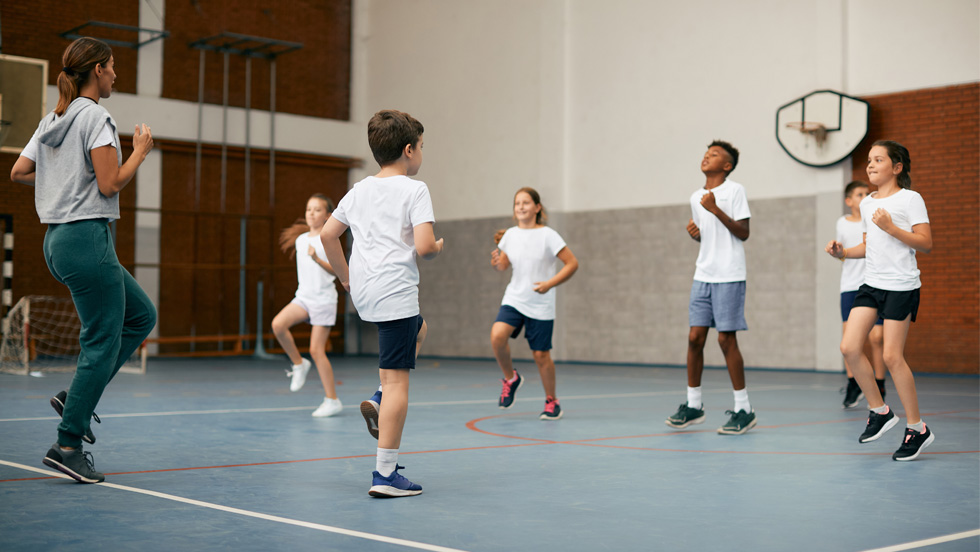
An Adelphi University researcher says attitudes formed toward physical education by students as early as elementary school may have long-term implications for their health as adults.
As a kid, Kevin Mercier, EdD, professor and chair of the Department of Health and Sport Sciences, was always a better-than-average athlete. Good enough that he played varsity basketball while an undergraduate at Ithaca College. “My perspective as a student was that sports and physical education were fun,” he says. Dr. Mercier eventually became a physical education teacher at a public high school, but as he observed his students over that 13-year portion of his career, the fun wore off. He came to believe programs such as his were largely ignoring the students who needed them most.
Dr. Mercier saw, in fact, that those students arrived in high school with highly negative expectations from the programs and from themselves. It seemed clear to him that those attitudes had their origin in the students’ younger years. But determining how to change their attitudes—the “what”—was dependent on first learning the “why”—the reasons they developed the attitudes in the first place.
Dr. Mercier is well on his way to finding both answers and solutions. Earlier this year, he and colleagues from institutions across the country published two papers reporting their findings. One, “A Longitudinal Look at Student Attitude, Perceived Competence, and Fitness Test Performance of Elementary Students,” published in the International Journal of Physical Activity and Health, explored the interrelationships among student attitudes toward physical education, and the second, “Middle School Students’ Attitudes Toward Physical Activity and Physical Education, Intentions, and Physical Activity Behavior,” published in the European Physical Education Review, examined how older students feel about the PE class experience.
We asked Dr. Mercier what his teaching experience and his research revealed.
What did your experience as a physical education instructor teach you?
I realized we only catered to students who were competitive and liked team sports. The other students were left out. But physical education isn’t a gifted and talented program—it is supposed to be for everyone, and it should prepare all students for a lifetime of physical activity. Just favoring the athletes doesn’t meet the goal.
Why do negative feelings about physical activity—especially physical education—begin as early as elementary school?
Some students just naturally have greater physical or athletic capabilities than others, but it’s more than that. It’s also when fitness tests begin. Our research with fourth- and fifth-grade students over time showed that good fitness testing scores resulted in positive perceived competence. The reverse is also true. That makes sense, but while better fitness test scores may create a brief lift in positive feelings about physical education, our research showed that attitudes toward physical education developed over time, rather than in the moment—a conclusion not found in previous research. Also, some students may perceive fitness testing and physical education classes as add-ons, rather than being related to the educational goals of school. For those students who don’t perform well, however, this can be the beginning of negative self-perceptions and attitudes toward physical education.
You found big changes once students reached middle school. What were those?
Starting in sixth grade, there is an overall shift from liking to not liking physical education. Middle school is when a shift to team sports in PE class often begins, and many students may be pushed into activities and games for which they are not ready. There are hormonal and socialization changes that may cause some students to retreat into themselves, as well as clubs, hobbies and a variety of online activities that may contribute to an increasingly sedentary lifestyle. Attitudes decreased at a sharper rate for girls, who often still have fewer opportunities for physical activity at school, although this has improved over time and varies from community to community.
What recommendations do you have for generating more positive attitudes?
Choice is key. If you like something and are good at it, you’re more likely to want to do it. Allowing students to select the ways they plan to be active throughout life would benefit those most often turned off by traditional physical education. Context is also important. Fitness testing is something a lot of students don’t like. It can be beneficial, but not in the way it is implemented. It needs to be presented not as competition but as a source of important measurements, such as heart health versus muscle building. Image counts, too. Not putting students on display or in embarrassing situations would help. Too often, teachers rush to play sports when a percentage of students, those who are low-skilled, don’t have the ability or knowledge of how to be successful in those sports. A focus on helping all students develop the skills, strategies and knowledge should be a component before playing a sport. Another plus: Studies show that people who are more fit do better academically.
A recent analysis from the U.S. Centers for Disease Control and Prevention reported that half of adolescents aged 12 to 15—middle-school-aged children—are considered physically unfit. How does that relate to your research?
Obesity rates among children continue to increase, and fitness levels often decrease as students age. Our research does not focus necessarily on the short term, as physical education classes do not meet regularly enough to immediately impact obesity. We focus more on the long term and trying to help students develop the knowledge, skills and attitudes to be active throughout life.
Do you plan additional research?
My colleagues and I are continuing to look at how decisions teachers make, specifically regarding the physical education curriculum, impact current and future decisions to be active. We are also looking at how physical activity experiences outside of physical education are impacting their attitudes toward current and future physical activity.